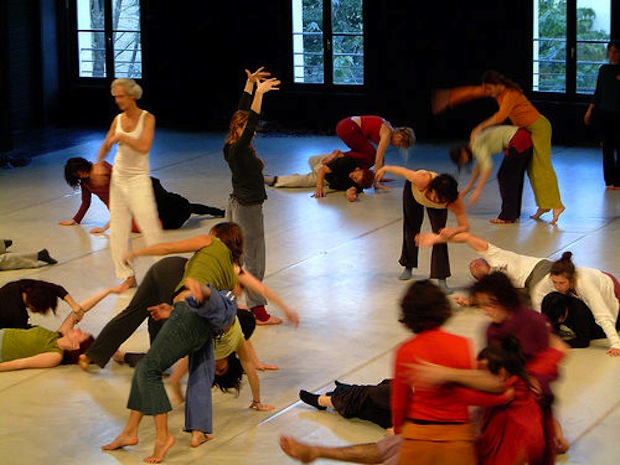I counsel individuals of all ages as they struggle in their relationships with friends, partners, and family members. It goes with the territory when one is a rabbi. The people I counsel often have become attached to avoiding conflict, so when conflicts arise in their relationships – as they inevitably do – they are quick to interpret them as potentially catastrophic. They need their interactions to look a particular way in order to feel loved.
Our bodies can teach us about these dynamics. In the “Contact Improvisation”?video below, dancers maintain a point of contact between them as they move. The dance might draw them both to the floor, or lead one partner to drape the other over her shoulder. Years ago, I attended a Contact Improvisation workshop. The teacher of this particular workshop instructed us to “touch with hands that don’t want.” This was a practical suggestion: if one partner becomes single-mindedly driven to execute a particular dance move, he stops paying attention and responding to his partner. The dance comes to a clumsy halt. People fall, or get injured.
But to me, this teaching also serves as spiritual guidance. When I am dancing, rather than focusing on an interaction as a zero sum game (one person wins, the other loses), dancing with “hands that don’t want” allows both partners to harmonize with each other’s movement impulses by relinquishing the demands of their egos, dissolving into the flow of the dance, almost as if they are a single body in motion. In my experience, the magic of this moment is impossible to articulate. I feel held, cared for – loved by a force bigger than either my dance partner or myself.
Off the dance floor, when I “touch with hands that don’t want” I am able to be more generous with a friend or family member who has a set of desires and needs that might momentary conflict with my own. In our relationships with friends, partners and family, we too often touch with hands that want, metaphorically tightening our fists to defend ourselves, or to grasp a partial truth of a situation as we justify our actions. If we open our hearts and “touch with hands that don’t want”, a dance with life, with the fullness of the person before us, can emerge.
Next time you find yourself in a challenging encounter with someone, rather than instinctively tightening around what you want, picture an open hand holding you and person you’re talking to, a hand that does not desire anything in particular for either of you, but is open to any possibility. As mindfulness teacher, Sharon Salzberg says, in the midst of loving connection…
“[we must also] practice letting go — trying to find that balance between needing something to be a certain way for us, which is attachment, [with] openness, awareness, and a generosity of the heart. This openness and generosity is love — for ourselves, for all beings, for life itself.”
As you practice “touching with hands that don’t want”, notice the great love and care that transcends and includes both you, and the other person. You might be surprised by what happens next.

Rabbi Adam Lavitt is a spiritual leader, educator, and writer living in Philadelphia, where he serves as the campus rabbi at Swarthmore College. He was ordained at the Rabbinical School of Hebrew College, where he also received a Master?s in Jewish Education, and a Certificate in Pastoral Care. He has been a Liturgist in Residence at the National Havurah Institute, and a CLAL Rabbis Without Borders Fellow.

